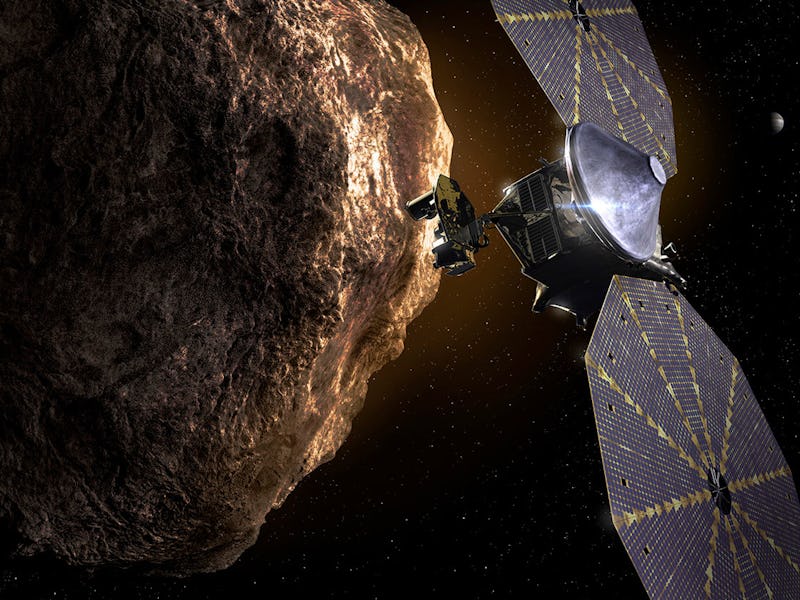NASA is sending ‘Lucy’ to a mysterious celestial location
The first mission of its kind will explore the origins of the Solar System.

Jupiter is a popular planet. The gas giant has 79 confirmed moons orbiting around it, a system of dusty rings surrounding, and a gang of rocky bodies that follow its orbit around the Sun.
The Trojan asteroids are two groups of such rocky bodies that lead and follow Jupiter, and they may have been accompanying the large planet for the past four billion years. Although the asteroid group is quite chummy with Jupiter, very little is known about them -- as no spacecraft has ever made the journey to visit the Trojans.
However, that will soon change as NASA is gearing up to send Lucy on a 12-year trip where it will observe six of these previously unexplored celestial bodies around Jupiter. And Lucy is one step closer to launch, as NASA's team of engineers integrated one of its most important instruments to the spacecraft.
On Tuesday, NASA announced that the Lucy Thermal Emission Spectrometer, one of the mission's three scientific instruments, was successfully integrated to the spacecraft on December 16.
The instrument is essentially going to act as a remote thermometer, measuring the far-infrared energy emitted by the Trojan asteroids in order to get a better idea of the material that makes up these rocky bodies.
The L'TES instrument was successfully installed to the spacecraft in the cleanroom at Lockheed Martin in Waterton Canyon, Colorado.
What is the Lucy mission?
The mission is named after the fossilized human skeleton that was found in 1974. Lucy's scientific name is AL 288-1, but she is better known as Lucy.
In turn, Lucy was named after the Beatles song, “Lucy in the Sky With Diamonds,” which the team of paleontologists who made the discovery were listening to at camp the night they found her.
The fossils have revolutionized what we know about the origin story of our ancestors, the same way the Lucy mission aims to help us piece together the origin story of the Solar System.
NASA first selected Lucy in January, 2017 as the first mission to explore the Trojan asteroids.
“Because the Trojans are remnants of the primordial material that formed the outer planets, they hold vital clues to deciphering the history of the solar system," Harold F. Levison, Lucy principal investigator from Southwest Research Institute (SwRI) in Boulder, Colorado, said in a statement at the time. "Lucy, like the human fossil for which it is named, will revolutionize the understanding of our origins.”
Over its 12-year mission, Lucy will study six of the mysterious Trojans and one asteroid from the asteroid belt, which is located roughly between the orbits of Jupiter and Mars.
The Lucy spacecraft will spend 12 years in space, hopping between different Trojan asteroids.
What are the Trojan asteroids?
The first of the Trojans was discovered on February 22, 1906 by German astronomer Max Wolf. Eight months later, another German astronomer, August Kopff, discovered a second asteroid followed by a third discovery in February, 1907.
By the year 2017, more than 6,500 Trojan asteroids had been spotted.
The asteroids orbit the Sun in two main groups, one that leads ahead of Jupiter and another that follows behind.
Astronomers have only been able to observe these asteroids using telescopes, but no spacecraft has ever paid them a visit. Although they know very little about the Trojans, scientists believe that they may have been scattered from all over the outer Solar System during its early history billions of years ago, and have been trapped in these stable positions ever since, according to NASA.
What will the Lucy mission accomplish?
Asteroids formed from the very same material that formed the Solar System, and may contain clues as to how water and other biological material made their way to Earth, and sparked life as we know it.
Therefore, by studying asteroids, scientists get a better understanding of not only how life may have originated on Earth, but how the entire Solar System was formed as well.
In order to do that, Lucy will study the geology, surface composition, and physical properties of the Trojan asteroids at close range. The mission aims to determine the mass and density of each asteroid, and figure out the material from which they formed.
“Understanding the causes of the differences between the Trojans will provide unique and critical knowledge of planetary origins, the source of volatiles and organics on the terrestrial planets, and the evolution of the planetary system as a whole,” Catherine Olkin, the mission’s deputy principal investigator from Southwest Research Institute, said in a statement.
When will Lucy launch?
Lucy is scheduled to launch in October 2021.
The spacecraft will spend six years on its way to its first target, the Main Belt asteroid Donaldjohanson, which was named after one of the co-discoverers of the Lucy fossil.
After its first stop, Lucy will then spend more than 3000 days before it reaches its first Trojan asteroid, Eurybates. The spacecraft will encounter three more Trojans before it flies by the final pair, Patroclus and Menoetius in the year 2033.
By then, Lucy will have collected a plethora of unprecedented information on these mysterious bodies that can inform us of our origins.
This article was originally published on